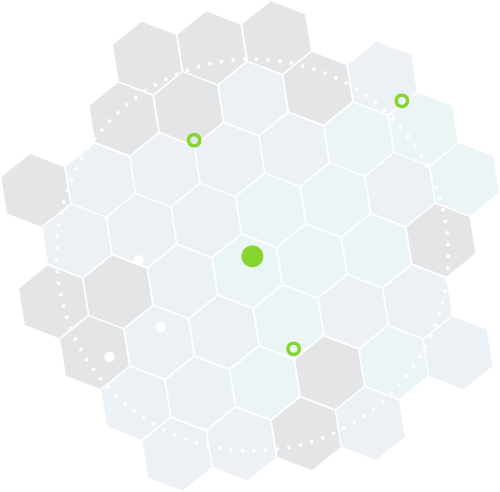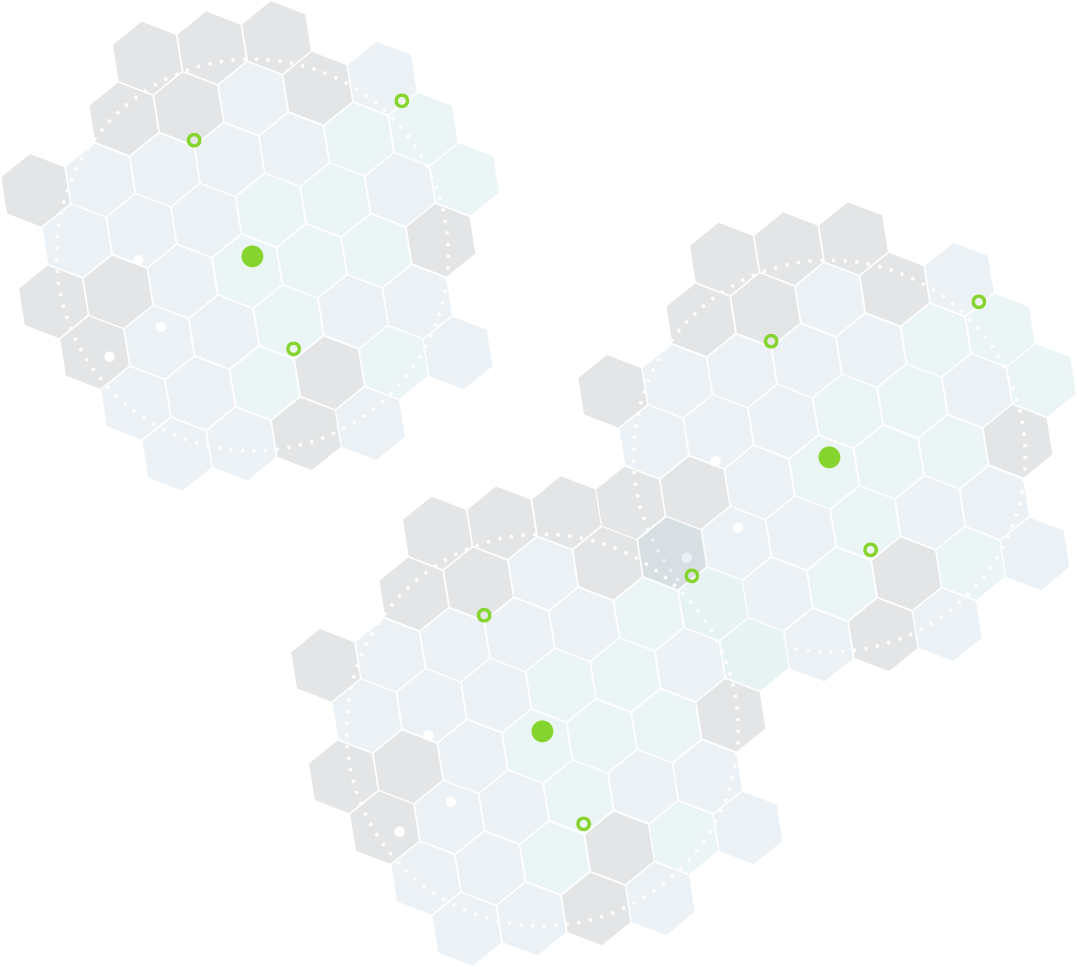Forests in Focus uses trusted data from the USDA Forest Service, NatureServe and other reputable sources to power a landscape-level assessment of continental US timberland. In this technical summary we will review the following topics:
- Dashboard Features
- Risk Categories
- Powering the Tool: Criteria, Data Sets, Sources and Updates
- Foundations of Analysis
- Data and Analysis Limitations
- Advisory Committees
This page provides a transparent look at methodological decisions and platform components that are useful for both prospective and current Forests in Focus members.
Dashboard Features
We assess risk using features (geolocated polygons) with distinct spatial scales. The symbol, “~” indicates an approximate value.
| Feature | Dimensions |
| Plot* | Plots are representative sampling units commonly used in field sampling. The FIA program collects information on forest health metrics using plots across the United States. |
| Hexagon (Hex or “Instance”) |  A six-sided polygon with an approximate area of 190,000 acres. This is the smallest unit of area for which we display a risk assessment and offer sustainability insights. A six-sided polygon with an approximate area of 190,000 acres. This is the smallest unit of area for which we display a risk assessment and offer sustainability insights.
|
| Assessment Area |  This approximately 8.5 million acre area surrounds ONE [selected] mill and represents a theoretical supply basin where forest products are likely sourced.** It is composed of the approximately 44 to 46 hexes that (in full or in part) fall within a generic 50-mile sourcing radius. This approximately 8.5 million acre area surrounds ONE [selected] mill and represents a theoretical supply basin where forest products are likely sourced.** It is composed of the approximately 44 to 46 hexes that (in full or in part) fall within a generic 50-mile sourcing radius.
|
| Combined Assessment Area |  Combined Assessment Areas are associated with a selection of multiple mills, and represent the areas from which these mills are likely to source their forest products. This aggregated unit of measurement is only available in the Summary Dashboard, and is useful for companies that want to summarize risks for their enterprises or specific product lines. We account for any overlaps in Assessment Areas to ensure that the underlying land area is not “double-counted”. Combined Assessment Areas are associated with a selection of multiple mills, and represent the areas from which these mills are likely to source their forest products. This aggregated unit of measurement is only available in the Summary Dashboard, and is useful for companies that want to summarize risks for their enterprises or specific product lines. We account for any overlaps in Assessment Areas to ensure that the underlying land area is not “double-counted”.
|
*The number of plots within a hexagon and thus within an Assessment Area (or Combined Assessment Area) may vary, impacting statistical reliability due to variation in sampling, small sample sizes and/or lack of uniformity.
**Actual sourcing regions are specific to each mill and vary by tree species, seasonality, markets and other factors.
Risk Categories
We use three categories (lower, medium and higher) to communicate the level of risk to Forests in Focus members. Risk type is assigned to hexes and Assessment Areas based on predetermined thresholds.
RISK CATEGORIES
| LOWER RISK | MEDIUM RISK | HIGHER RISK | |
| Land Use Change | Less than or equal to 1% net loss of timberland annually, or a 5% net loss over a five-year period. | Between 1% to 2% net loss of timberland annually, or a 5% to 10% net loss over a five-year period. | More than 2% net loss of timberland annually, or a 10% net loss over a five-year period. |
| Forest Carbon | Less than or equal to 1% net loss of above-ground wood volume annually, or a 5% net loss over a five-year period. | Between 1% to 2% net loss of above-ground wood volume annually, or a 5% to 10% net loss over a five-year period. | More than 2% net loss of above-ground wood volume annually, or a 10% net loss over a five-year period. |
| Imperiled Species | No known imperiled or critically imperiled species present. | Count of imperiled or critically imperiled species that is less than or equal to the national median (2 in a Hexagon or 27 in an Assessment Area). | Count of imperiled or critically imperiled species that is greater than the national median (2 in a Hexagon or 27 in an Assessment Area). |
| Imperiled Ecosystems | No known imperiled or critically imperiled ecosystem types present. | Count of imperiled or critically imperiled species that is less than or equal to the national median (2 in a Hexagon or 6 in an Assessment Area). | Count of imperiled or critically imperiled species that is less than or equal to the national median (2 in a Hexagon or 6 in an Assessment Area). |
| Illegal Harvesting | An FSC-conducted National Risk Assessment concluded there is low risk of illegal harvesting in the contiguous United States. | N/A | N/A |
| GMO Trees | An FSC-conducted National Risk Assessment concluded there is low risk of commercial GMO tree use in the contiguous United States. | N/A | N/A |
Powering the Tool: Criteria, Data Sets, Sources and Updates
Forests in Focus provides an assessment of US timberland for 6 sustainability criteria. The table below provides information on these criteria, as well as for Ownership & Certification, Impact/Mitigation projects and other data sets (or layers) available in our dashboards.
| Name | Type | Data Source | Date Integrated | Last Refinement |
| Land Use Change | Criteria | US Forest Service | March 2019 | March 2019 |
| Forest Carbon | Criteria | US Forest Service | March 2019 | March 2019 |
| Imperiled Species | Criteria | NatureServe | August 2019 | August 2019 |
| Imperiled Ecosystems | Criteria | NatureServe | August 2019 | August 2019 |
| Illegal Harvesting | Criteria | FSC National Risk Assessment (NRA) Specified Risk | February 2019 | February 2019 |
| GMO Trees | Criteria | FSC National Risk Assessment (NRA) Specified Risk | February 2019 | February 2019 |
| Ownership & Certification | Criteria | US Forest Service, ATFS, SFI, FSC | Ownership: February 2019 Certification: November 2019 – January 2020 |
April 2020 |
| Impact / Mitigation Projects | Criteria | American Forest Foundation | April 2020 | April 2020 |
| FSC NRA High Conservation Value (HCV) and Conversion Specified Risk | Data Sets (or Layers) | FSC National Risk Assessment (NRA) Specified Risk | February 2019 | February 2019 |
| Mills | Data Sets (or Layers) | University of Georgia / Forisk | December 2019 | Ongoing* |
*This dataset is dynamic, as mills open, close and add on new capacities. Members who own or have working relationships with a mill(s) may submit requests to update mill information.
Foundations of Analysis
Data from the USDA Forest Service’s Forest Inventory and Analysis (FIA) program is a cornerstone of the Forests in Focus landscape assessment. The program collects data on forest area and location; species, size, and health of trees; total tree growth, mortality, and removals by harvest; in wood production and utilization rates by various products; and in forest land ownership. Using this robust data set, the FIA program is able to reputably report on the status, trends, and condition of America’s forests.1,2
Possible Data and Analysis Limitations
Forests in Focus was designed to assess sustainability criteria at a landscape level, meaning there are statistical limitations to analysis and results at finer spatial scales. As a result, conclusions at the Assessment Area (or Combined Assessment Area) level are more reliable than those at the hexagon level.
Pertaining to USDA FIA Data:
The FIA methodology we utilize is designed to support an understanding of the nation’s forest resource and to support observations about trends at different scales. The entire national inventory is completed approximately every five years, though some states and regions are fully surveyed over shorter (Wisconsin and portions of the Southeast, for example) or longer (portions of the Intermountain West, for example) intervals. As with any analysis, there are statistical limitations to results, especially at finer scales. FIA data plots, for example, may not be evenly distributed across a landscape, affecting statistical reliability due to a small sample size. Furthermore, several states including Wyoming, New Mexico and Nevada were not included in the Forests in Focus assessment, as the FIA data was insufficient to provide calculations consistent with the other states.
Pertaining to NatureServe Data:
The methodology we utilize is designed to support an understanding of the nation’s forest resource and to support observations about trends at different scales. As with any analysis, there are statistical limitations to results, especially at finer scales. The biodiversity criterion does not display imperiled species information for Massachusetts, Pennsylvania, and Rhode Island or for imperiled plant species located in Washington state.
Advisory Committees
Forests in Focus leverages the expertise from two distinct advisory committees:
The General Advisory Committee (GAC) – Currently led by GreenBlue
The purpose of the GAC is to assist the Forests in Focus team in ongoing strategic development and platform growth. This group of stakeholders brings an industry perspective that is integral to identifying key gaps and issues for the Forests in Focus platform to address. Committee members are outlined below:
| Organization | Representative | Title |
| Domtar | Paige Goff | Vice President, Sustainability |
| Georgia-Pacific | John Mulcahy | Vice President, Sustainability |
| Mars Inc. | Rachel Goldstein | Global Sustainability Senior Manager |
| McDonald’s | Jeff Fitzpatrick-Stilwell | Senior Manager, North America Sustainability |
| Quad Packaging | Paul Nowak | Vice President, Enterprise Solutions |
| Sappi North America | Rebecca Barnard | Forestry Certification Manager |
| Staples | Jake Swenson | Director of Sustainability |
| Target | Benjamin Hansen | Principal, Sustainable Product Development |
| WestRock | George D’Urso | Director, Fiber Sustainability |
| Weyerhaeuser | Chad Leatherwood | Environmental Manager – Raw Materials and Residuals |
The Technical Advisory Committee (TAC) – Lead by The American Forest Foundation
Following testing in the marketplace, a Technical Advisory Committee (TAC) will convene to formally review and provide technical governance for Forests in Focus. To avoid conflicts of interest, or the appearance of conflicts of interest, TAC members will have no professional affiliation with Forests in Focus investors, customers, partners or vendors.
1 USDA Forest Service. 2005. Forest Inventory and Analysis Sampling and Plot Design. FIA Fact Sheet Series.
2 USDA Forest Service. Forest Inventory and Analysis. Website.
